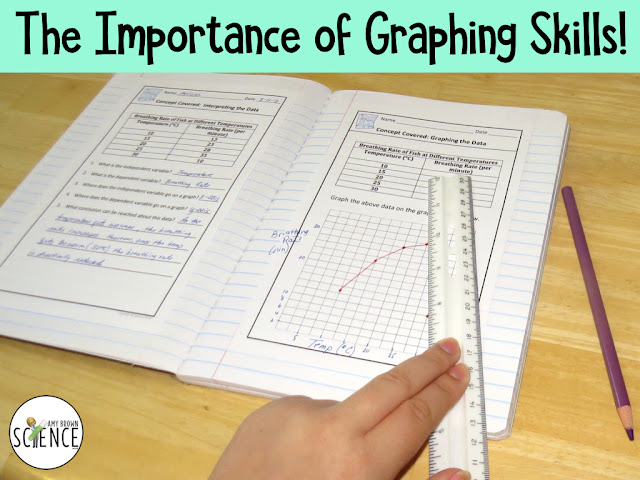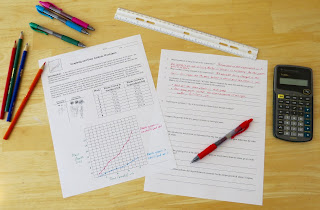Graphing: Make this a part of as many lessons as possible!
The lessons learned in a science class go much further than just learning the parts of the cell, or the parts of an atom, or the names of the invertebrate phyla, or the trends seen on the periodic table. We teach important skills that our students will carry with them for the rest of their lives. Skills such as graphing, metric measurement, cause and effect, percentages, scientific method, logical problem solving, and critical thinking are required for LIFE!
For this blog post, I would like to focus on graphing skills. I fear that the use of graphing calculators and laboratory probe systems is doing too much work for our students. I do love using technology in my classroom and lab, but I think that too much of it is actually hurting our students. Many students are reaching my high school science classes without a clear understanding of how to construct a graph. We need a healthy balance between allowing technology to do the work for us, and doing the work for ourselves.
There are so many benefits of giving the student a pencil, a ruler, and a piece of graph paper.
- Graphing the "old-fashioned" way improves fine motor skills and hand-eye coordination.
- Graph construction forces the student to think about the independent and dependent variables and to consider which axis to place them on to show a logical correlation between the two.
- It provides an excellent opportunity to teach our students to "think ahead of the problem" to consider if an outcome or conclusion is logical.
- Every standardized test our students take will require them to analyze graphs and tables. Data analysis is a hard concept for many students, but requiring them to construct their own graphs and tables encourages deeper thinking of the data shown on the graph.
- There is no better way to teach "cause and effect" than by graphing data.
- Graphing provides a pictorial representation of data which helps students learn to draw accurate conclusions.
Obviously, we want students to become masters of problem solving and critical thinking, and teaching graphing skills all year long is one way to assure that our students are good thinkers. Make your labs and classroom activities "quantitative" in nature whenever possible. Especially in biology, many activities are "qualitative" and involve drawing and describing, but we need to constantly look for opportunities to use labs and other lessons that are math-based and involve the collection of numerical data.
- Look at the labs you are currently using with your students. Is it possible to have students graph the data they collect? If so, then always require it!
- It is really important that students construct graphs that have more than one line of data on the same graph. By placing several lines of data on the same graph, students can quickly see the correlation between the independent and dependent variables. It provides excellent practice in how to analyze data to reach a proper conclusion.
- You can provide additional problem solving questions to accompany the graphing activity, such as "What do you suppose would happen if this were changed....", or "What would be the outcome if...."
- Include interpolation and extrapolation questions whenever possible. Students need to be able to predict new outcomes based on the data shown on a graph.
I hope these reasons will convince you to include more tabling, graphing and analyzing of information. But, please!!! No graphing calculators until your students are proficient at graphing and data analysis skills!!! I firmly believe the calculator is crippling our students. The calculator is a wonderful tool.....but AFTER the student can do the skill without the calculator.
If you need help with incorporating more graphing and data analysis into your classes, these resources will help:
Tabling, Graphing and Analyzing Data - PowerPoint with Notes for Teacher and Student
Graphing Practice Problems - Great graphing practice with critical thinking questions.
Graphing and Data Analysis - This is a free download that provides good review and reinforcement in graphing and data analysis.
Graphing, Scientific Method, and Scientific Writing - More great science skills practice!
The following lab activities require graphing as a means of data analysis:
Using a Graph to Find Area - This is another free download and a good graph is the only way to solve the problem.
Lab: Acids, Bases and Cells Requires extensive graphing of results.
Modeling Population Growth
The Effect of Concentration on the Rate of Diffusion - Another free download!
Graphing Practice Problems - Great graphing practice with critical thinking questions.
Graphing and Data Analysis - This is a free download that provides good review and reinforcement in graphing and data analysis.
Graphing, Scientific Method, and Scientific Writing - More great science skills practice!
The following lab activities require graphing as a means of data analysis:
Using a Graph to Find Area - This is another free download and a good graph is the only way to solve the problem.
Lab: Acids, Bases and Cells Requires extensive graphing of results.
Modeling Population Growth
The Effect of Concentration on the Rate of Diffusion - Another free download!































